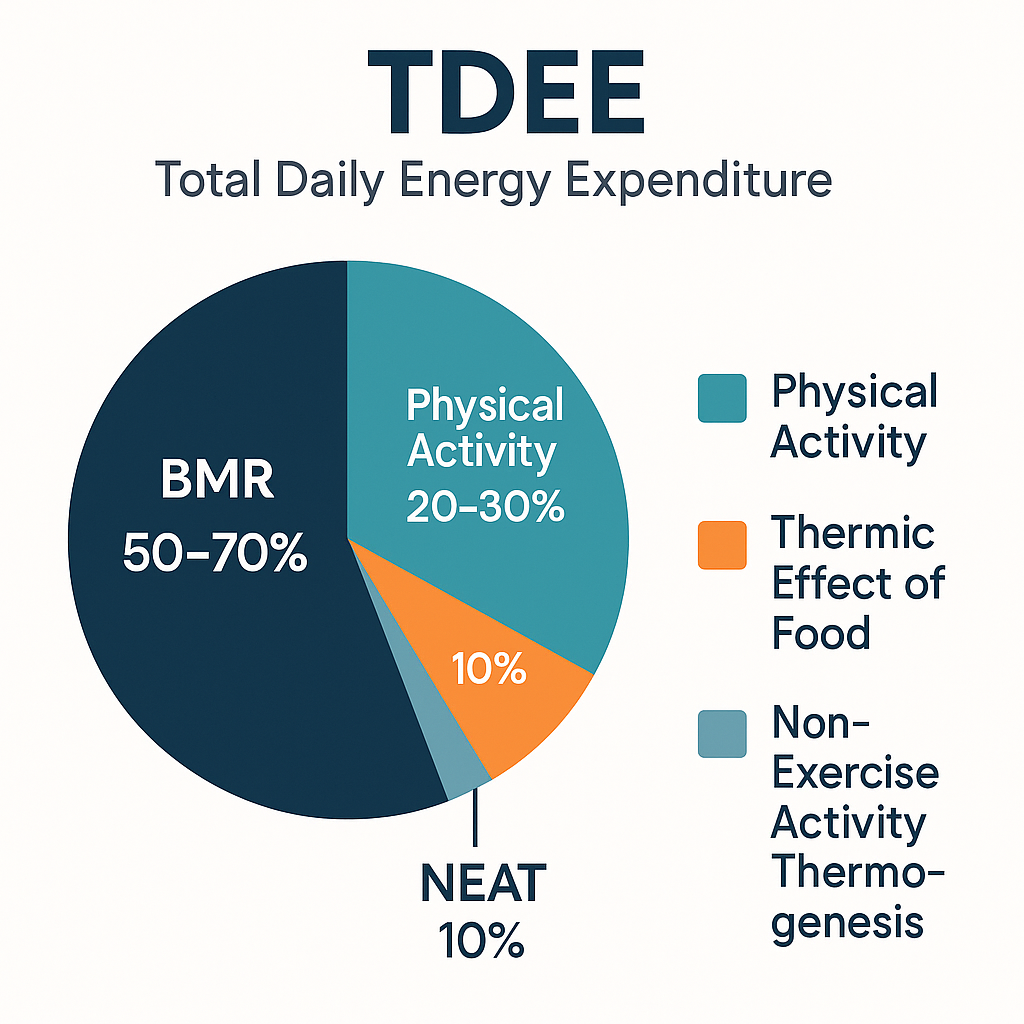Understanding TDEE: Your Total Daily Energy Expenditure
TDEE is the foundation of any successful weight management plan. Understanding your Total Daily Energy Expenditure is crucial for setting realistic calorie goals and achieving lasting results.
What is TDEE?
TDEE stands for Total Daily Energy Expenditure. It represents the total number of calories your body burns in a 24-hour period, including all activities from sleeping to intense exercise.
Think of TDEE as your daily calorie "budget" - the amount of energy your body uses to maintain all its functions and activities. Understanding this number is essential for weight loss, weight gain, or weight maintenance.
Ready to boost your workouts?
Discover the exercise routines that maximize calorie burn in minimal time.
Free guide • No spam • Unsubscribe anytime
The Four Components of TDEE
Your TDEE is made up of four main components:

1. Basal Metabolic Rate (BMR) - 50-70%
The calories your body burns at complete rest to maintain basic physiological functions like breathing, circulation, cell production, and brain function. This is typically the largest component of TDEE, accounting for 50-70% of your total daily energy expenditure.
2. Physical Activity (Exercise) - 20-30%
Calories burned through planned, structured physical activity like gym workouts, running, or sports. This is the component most people focus on when trying to lose weight, though it typically represents a smaller portion of total daily calories than many people expect.
3. Thermic Effect of Food (TEF) - 10%
The energy cost of digesting, absorbing, and processing the food you eat. Protein has the highest thermic effect (20-30% of calories consumed), followed by carbohydrates (5-10%), then fats (0-3%).
4. Non-Exercise Activity Thermogenesis (NEAT) - 10%
Calories burned through all activities that aren't sleeping, eating, or formal exercise. This includes fidgeting, maintaining posture, and daily activities like typing or walking to the car. NEAT can vary significantly between individuals.
How to Calculate TDEE
The most common method to calculate TDEE is to multiply your BMR by an activity factor:
TDEE Formula
TDEE = BMR × Activity Factor
Activity Factors:
- Sedentary (1.2): Little or no exercise, desk job
- Lightly Active (1.375): Light exercise 1-3 days/week
- Moderately Active (1.55): Moderate exercise 3-5 days/week
- Very Active (1.725): Hard exercise 6-7 days/week
- Extremely Active (1.9): Very hard exercise, physical job
Step-by-Step Example
Let's calculate TDEE for a 30-year-old woman, 65kg, 165cm, moderately active:
- Calculate BMR: 10(65) + 6.25(165) - 5(30) - 161 = 1,384 calories
- Apply activity factor: 1,384 × 1.55 = 2,145 calories
- TDEE: 2,145 calories per day
Why TDEE Matters for Weight Management
For Weight Loss
To lose weight, you need to create a calorie deficit by consuming fewer calories than your TDEE. A deficit of 500 calories per day typically results in about 1 pound of weight loss per week.
For Weight Gain
To gain weight, you need a calorie surplus by consuming more calories than your TDEE. A surplus of 300-500 calories per day is often recommended for lean muscle gain.
For Maintenance
To maintain your current weight, aim to consume calories equal to your TDEE. This creates energy balance where calories in equal calories out.
Want to optimize your metabolism?
Learn the science-backed methods to naturally boost your metabolic rate.
Free guide • No spam • Unsubscribe anytime
Factors That Affect TDEE
Several factors can influence your TDEE:
- Age: TDEE typically decreases with age due to muscle loss and reduced activity
- Gender: Men typically have higher TDEE due to more muscle mass
- Body composition: More muscle mass = higher TDEE
- Genetics: Some people naturally have faster or slower metabolisms
- Hormones: Thyroid function, insulin sensitivity, and other hormones affect metabolism
- Sleep: Poor sleep can reduce TDEE and affect hunger hormones
- Stress: Chronic stress can impact metabolism and food choices
- Diet history: Previous dieting can temporarily reduce metabolic rate
Common TDEE Calculation Mistakes
1. Overestimating Activity Level
Many people overestimate their activity level. If you work a desk job and go to the gym 3 times per week, you're likely "lightly active," not "moderately active."
2. Not Adjusting Over Time
Your TDEE changes as you lose or gain weight. A smaller body burns fewer calories, so you'll need to recalculate your TDEE periodically.
3. Ignoring Individual Variation
TDEE calculators provide estimates. Your actual TDEE might be 10-15% higher or lower than calculated. Use the calculation as a starting point and adjust based on real-world results.
How to Increase Your TDEE
If you want to burn more calories daily, focus on these strategies:
- Build muscle: Muscle tissue burns more calories at rest than fat tissue
- Increase NEAT: Take stairs, park farther away, fidget more, stand while working
- Add cardio: Regular cardiovascular exercise increases daily calorie burn
- Eat protein: Protein has a higher thermic effect than carbs or fats
- Stay active throughout the day: Avoid long periods of sitting
- Get quality sleep: Poor sleep can reduce metabolic rate
The Bottom Line
TDEE is your daily calorie baseline - the foundation for any nutrition or fitness goal. While calculators provide good estimates, remember that your actual TDEE is unique to you and may require some trial and adjustment to determine accurately.
Use TDEE as a starting point, track your progress, and adjust your calorie intake based on real-world results. Combined with consistent habits and patience, understanding your TDEE is a powerful tool for achieving your health and fitness goals.
Calculate Your TDEE Now
Use our free calculator to determine your personalized TDEE and calorie deficit for weight loss.
Calculate My TDEE